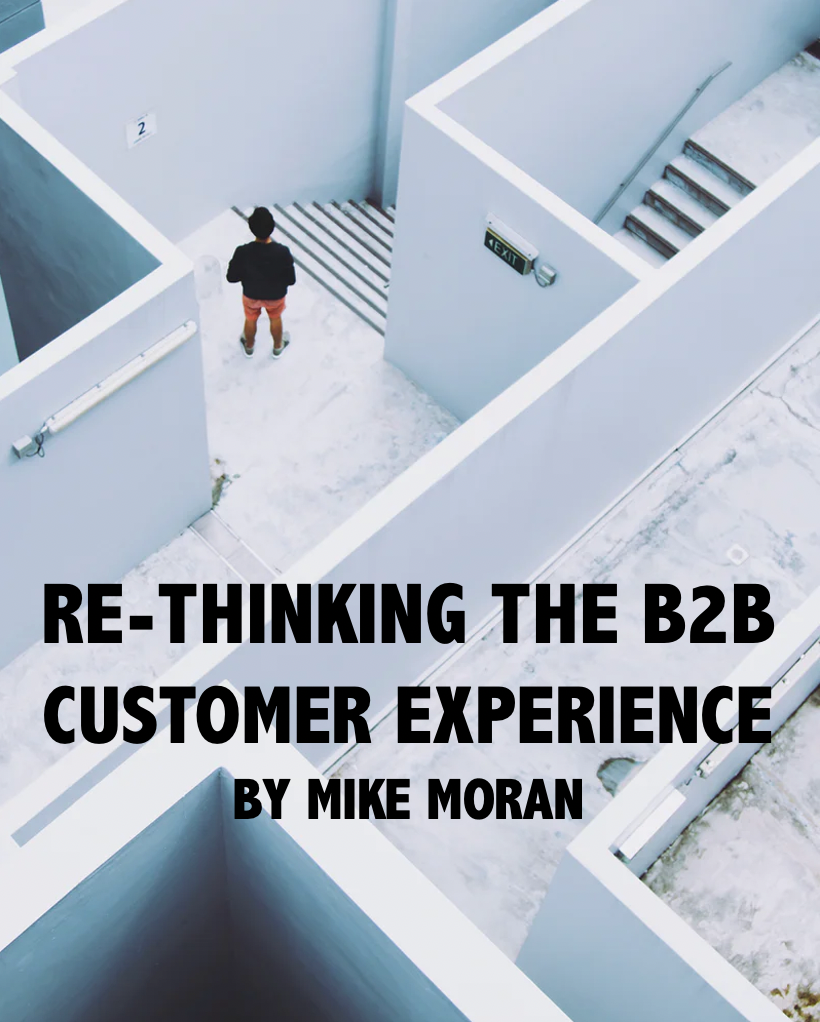By Mike Moran, {grow} Community Member
B2B sites are not usually hailed as the paragon of great digital experience.
If you’re not excited about the B2B customer experience (CX) for your website, you’re not alone. And I’m sure that it isn’t from lack of effort. You’ve tried to improve the content, freshen up the design, and overhauled the content management templates.
But you know that those improvements didn’t really improve the experience.
It’s time to ask yourself what would make the difference. What would really set your site apart from your competitors as the best digital CX?
To answer that question, you might want to think about what the purpose is for your website. “To drive leads” might be your quick answer. And you are right. But let’s state it from your customer’s point of view. What is the purpose of the website for your customer?
Your customer isn’t trying to become a lead. Your customer didn’t wake up this morning and say, “You know, I think I will find a website to fill out a form with my email address” or “I really want to be contacted by sales today.” No.
- Your customer is trying to solve their problem.
- Your customer is researching something and is looking for information.
- Your customer is trying to find a solution to their pain.
Amazon-ify your site?
You’ve probably put a lot of thought into your home page and site navigation. You’ve thought and thought about how to lay out the parts of your site so that people can navigate to the places they want to go.
But it’s hard for you to place yourself in your customer’s shoes, because you’ve forgotten more about your business than they will ever know. So, what seems like a logical B2B customer experience to you might be puzzling to someone with less experience than you.
So, maybe a better way to think about this is to ask yourself what you do when you come to a website as a customer. How do you like to find what you’re looking for? Or maybe ask yourself, what website out there is a great B2B customer experience? Which one really works?
Raise your hand if you thought of Amazon. (OK, you can put it down now — you really look a little silly.)
What is it about Amazon that makes it so good? And what is it that you do when you get there? Do you say to yourself, “OK, I am looking for a book, so let me click … here it is: Books. And I guess you would call it a mystery, so let me see if I can find–“No!
You search.
You just type in what you know and let fly. You probably can’t remember the last time you clicked a link on Amazon’s navigation. You search and it finds. Perfect.
And what happens after you land on that perfect page? You start reading all about the product and you eventually come to the Related Products section. And maybe you look at some of those. Did you know that fully 35% of Amazon purchases come from that recommendation engine?
To optimize the B2B customer experience, those are the two things your website needs to do.
- Recommend the right content when people search.
- Recommend the right content when they don’t — when they just navigate through your site.
B2B customers are still B2C customers!
It’s true that B2B sites are normally very different from Amazon. Most B2B sites have no eCommerce at all — even the ones that more offline than online. It doesn’t matter.
Every B2B customer you have is also a B2C customer. They’ve been conditioned to expect “Amazon.” And that experience sets the bar for CX. Amazon is easy and you … aren’t.
So, you’re right. B2B sites are not like Amazon. The problem for you is that your customer wants your site to be like Amazon. They want to search and find things. They want you to see what they are looking at and recommend something else that is relevant.
You still might not believe me. You checked your numbers and hardly anyone searches on your site — maybe only 1 percent of your visitors search. So, if they don’t want to search, why should you fix your site search experience?
- Your site search results page is a very popular page. Even if only 1 percent of your visitors search. that’s still one of the most popular pages on your site. If you think about the time and money you sink into crafting your home page and the other popular pages on the site, how do you justify spending so little resources on search?
- You know that your customers want to search. Check the amount of traffic you get to your site from Google and other search engines. For most companies, it’s more than 50 percent. So, how can it be that your customers love to search in Google, but suddenly like navigating when they get to your site? That doesn’t seem like it is about them. I wonder if …
- You’ve taught them to NOT search your site. If your search results stink on ice, your customers will quickly stop searching. They just won’t bother. It’s not that they don’t want to search. Your search experience has taught them that searching is a waste of time.
Face it. People want to search, so you need to make it work. You’re probably less resistant to the idea that people like seeing Related Content on the page — maybe you’ve even tried to make that work. The problem with this advice on making your site search and related content experiences better is that it’s too hard, right?
IT doesn’t own B2B customer experience
Which of the things that you work on are easy? Is it easy to drive email campaigns? Is creating good content easy? What’s the difference here? If you need this, you need this. If it’s hard, maybe you need to get to work, cupcake.
I don’t think you’re lazy. I think what’s really stopping you is that you don’t know what to do. We humans have this annoying way of staying in denial of problems that we don’t know how to solve. After all, why torture yourself with things you have no control over?
I’ve had smart B2B marketers tell me that the IT team owns the site search engine “because it’s technology.”
The marketing team runs the marketing automation system, the content management system, and all manner of crazy technologies, but site search is somehow included? And content recommendation seems even harder — do we need a data scientist for this?
Data science and artificial intelligence are actually part of the solution here — no one can fix site search by manually curating the “right” answers, and you can’t hand-craft rules for related content.
You need to find automation. And you can’t expect your IT team to solve this for you (or your analytics team or your data science team), even though they can be a big help. Only marketers can really decide whether the content being shown, whether the B2B customer experience is good enough.
Even if your IT team runs your CMS, they don’t decide the content on the site. Well, they shouldn’t decide the content shown on your search results page, either.
Even if your analytics team runs your dashboard, they don’t decide what a good benchmark is. They shouldn’t have final say on what your content recommendation engine does.
Marketers must step up to the responsibility of providing a good B2B customer experience, even if it involves technology, even if it involves analytics and data science, and, yes, even if it’s hard.
How can we make it a little less hard?
Technology and analytics lead the way, under the direction of B2B marketers. Technology is what gives you scale at low cost. Site search and content recommendation must continually improve themselves. Analytics measures that improvement. Sure, you should see more leads, but fundamentally your analytics must tell you whether customers are finding what they’re looking for.
That might seem magical, but there are actually many small behaviors that signal when customers find what they are looking for. They click deeper into the site. They spend more time on the page. They scroll. Conversely, other behaviors show failure. They click on the top navigation. They exit the site. Modeling these signals can reveal whether customers find what they are looking for, and allow you to start A/B testing changes in site search and content recommendation so that your B2B customer experience gets better and better.
That’s what Amazon does.
But no, you probably don’t ever need your experience to be as good as Amazon’s, even though that would be nice. But what if your CX was better than all of your competitors’ experiences?
Full disclosure: I serve as Senior Strategist for SoloSegment, a company that sells software to B2B marketers to fix their site search and show related content on every page. So, I have a vested interest in getting you to correct these problems. Maybe that causes you to discount what I am saying. I can’t control that. And it’s OK for you to decide that you don’t want help you solving these critical B2B customer experience problems.
What’s really not OK is to say that you won’t solve them. That they are not important. Or that they are too hard to fix. Or that your customers don’t need this. You use Amazon every day because of these two simple capabilities. Don’t ignore how important they are for your own site.
Mike Moran is the President of the Mike Moran Group, LLC where he is a speaker and consultant on digital marketing, content marketing, search, social media, and web and text analytics technology. He also serves as a senior strategist for Converseon, an AI powered consumer intelligence technology and consulting firm. Mike is a senior consultant for SoloSegment, a solutions company that uses marketing automation software and consulting services to simplify and amplify the B2B marketing that you already do.




